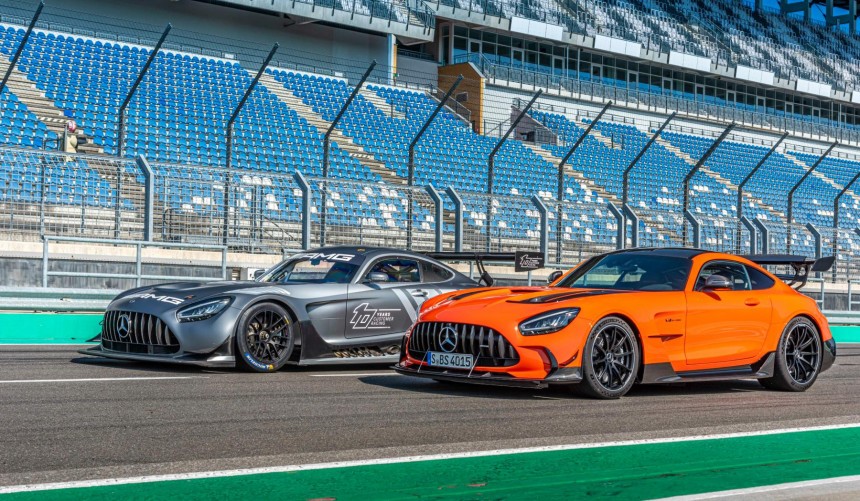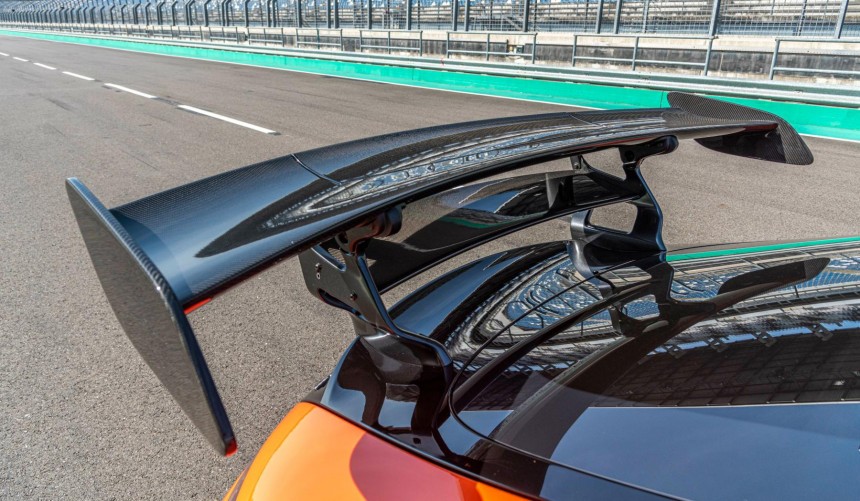By far the most technical racetrack in the world, the Nordschleife is the ultimate test for both drivers and cars. Going around it is no easy task but breaking a lap record is an outstanding achievement. It takes both a skilled driver and a powerful, aerodynamically superior supercar.
A few months ago, a Magma Beam Orange Mercedes-AMG GT Black Series completed a lap on the famous Nürburgring Nordschleife in just 6 minutes and 48 seconds, shattering the previous production car record held by the V12-powered Lamborghini Aventador SVJ.
At the wheel was long-time Mercedes-AMG factory driver, FIA GT World Cup Champion, and Nürburgring 24-hour winner Maro Engel.
However, a talented driver is never enough to topple records; the car must be up for the task too. In this case, the factory-spec Mercedes-AMG GT Black Series proved its powerful V8, modified Speedshift transmission, and sophisticated aerodynamics can deliver record-braking performance.
As with its siblings, the AMG GT R and AMG GT R PRO, the aerodynamics experts and designers from Mercedes’ AMG division closely collaborated to implement the latest innovations from the world of motorsport into this amazing machine.
Both visually and technically, the Black Series closely resembles the GT3 and GT4 racecars more than the standard, road-going supercar.
This is instantly noticeable when looking at the front of the car. The significantly larger front grille is borrowed from the AMG GT3, the wheel arch coolers are supplied with air directly by the central intake, while sickle-shaped flics on each side of the front bumper optimize airflow, increasing downforce and improving brake cooling.
Under the huge grille, the carbon fiber splitter adds to the list of racecar aero features. It can be manually adjusted to either Street or Race modes, enhancing driving dynamics according to the surroundings.
The second mode showcased at the Nürburgring extends the splitter forward, creating a front diffuser in the shape of an upside-down aerofoil profile. As the speed increases, this section is lowered even further by the rising negative pressure, which significantly speeds up the airflow across the underbody, creating the ground effect made famous by Lotus F1 cars in the late seventies.
This leads to a dramatic improvement in high-speed cornering, and that's exactly what you need for the 154 gruesome corners of the Nordschleife.
Another motorsport-specific addition to the Black Series is the new carbon-fiber hood that features two large exhaust air outlets. They guide hot air out of the engine compartment, while also contributing to the car’s extraordinary downforce. The air is also precisely guided around the A-pillars to the rear, where it increases the efficiency of the innovative rear wing.
From the back, the view is just as amazing and jam-packed with aerodynamic wizardry. The large diffuser incorporates a pair of rounded fire-spitting twin tailpipes and huge side vents that improve rear wheel airflow.
However, the revolutionary rear wing - or aerofoil concept, as Mercedes-AMG engineers call it – dominates the rear view and is an integral part of the car’s advanced aerodynamics.
It uses two blades made from carbon fiber that can be mechanically adjusted to suit different track conditions. The smaller, lower blade was designed to optimize the air arriving from the car's front end and optimize aerodynamic efficiency.
The big, upper blade features a movable flap that can be electronically adjusted by 20 degrees. In a flat position, it reduces air resistance, resulting in better acceleration. When it inclines, the flap dramatically improves braking performance and cornering stability.
To further enhance the car’s aerodynamic capabilities, engineers designed a fully paneled underbody equipped with specially developed longitudinal fins that accelerates airflow to the rear diffuser.
The result of all these enhancements is a downforce level of well over 400 kg (882 lbs) at 250 kph (155 mph), which helped Maro Engel fly through corners on his record-breaking run.
Mercedes-AMG’s dominance in motorsport provided an invaluable resource for the development of this astonishing street-legal, track-focused monster that will go down in automotive history as one of the most aerodynamically efficient production cars of all time.
At the wheel was long-time Mercedes-AMG factory driver, FIA GT World Cup Champion, and Nürburgring 24-hour winner Maro Engel.
However, a talented driver is never enough to topple records; the car must be up for the task too. In this case, the factory-spec Mercedes-AMG GT Black Series proved its powerful V8, modified Speedshift transmission, and sophisticated aerodynamics can deliver record-braking performance.
Both visually and technically, the Black Series closely resembles the GT3 and GT4 racecars more than the standard, road-going supercar.
This is instantly noticeable when looking at the front of the car. The significantly larger front grille is borrowed from the AMG GT3, the wheel arch coolers are supplied with air directly by the central intake, while sickle-shaped flics on each side of the front bumper optimize airflow, increasing downforce and improving brake cooling.
The second mode showcased at the Nürburgring extends the splitter forward, creating a front diffuser in the shape of an upside-down aerofoil profile. As the speed increases, this section is lowered even further by the rising negative pressure, which significantly speeds up the airflow across the underbody, creating the ground effect made famous by Lotus F1 cars in the late seventies.
This leads to a dramatic improvement in high-speed cornering, and that's exactly what you need for the 154 gruesome corners of the Nordschleife.
From the back, the view is just as amazing and jam-packed with aerodynamic wizardry. The large diffuser incorporates a pair of rounded fire-spitting twin tailpipes and huge side vents that improve rear wheel airflow.
It uses two blades made from carbon fiber that can be mechanically adjusted to suit different track conditions. The smaller, lower blade was designed to optimize the air arriving from the car's front end and optimize aerodynamic efficiency.
The big, upper blade features a movable flap that can be electronically adjusted by 20 degrees. In a flat position, it reduces air resistance, resulting in better acceleration. When it inclines, the flap dramatically improves braking performance and cornering stability.
The result of all these enhancements is a downforce level of well over 400 kg (882 lbs) at 250 kph (155 mph), which helped Maro Engel fly through corners on his record-breaking run.
Mercedes-AMG’s dominance in motorsport provided an invaluable resource for the development of this astonishing street-legal, track-focused monster that will go down in automotive history as one of the most aerodynamically efficient production cars of all time.














